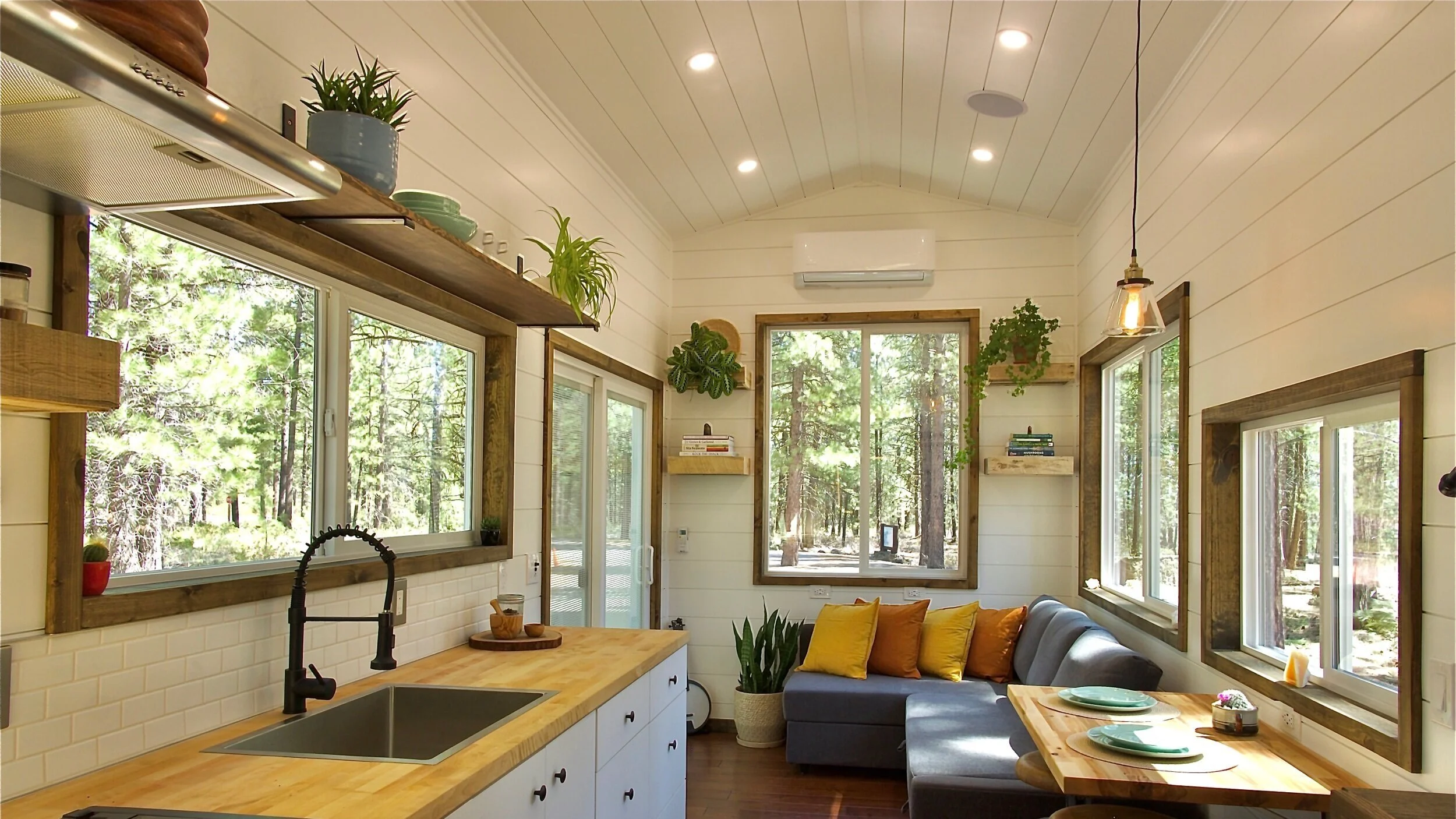You may have heard the joke that pets are the new kids, and plants are the new pets. While we don't entirely agree with this logic (why not all three?), we are absolutely in favor of adding a little more green to our modern tiny home.
So, which plants will thrive in a tiny home, and which is the right fit for your family?
Here are our top tips for growing an indoor jungle for your modern tiny home!
Health benefits of a greener tiny home
There's another reason why so many people are leaning into greenery: Indoor plants improve our mental and physical well-being by purifying the air, encouraging restful sleep, and reducing stress levels.
Fresher air indoors
Did you know that more than 85% of the average person's daily life is spent indoors?
Research suggests that keeping plants in your home helps rid the air of common toxins and indoor pollutants like formaldehyde and benzene.
One study found that the bromeliad plant removed over 80% of six volatile organic compounds in just 12 hours. Likewise, the dracaena plant removed 94% of acetone, the strong-smelling compound in most nail polish removers.
Improved sleep
Aromatic plants like jasmine, gardenia, and lavender give off scents that have been proven to calm nerves and help you sleep better. Plants also take in carbon dioxide and produce oxygen, freshening your air for a more soothing sleep. Some of these plants, like gerbera daisies, keep giving off oxygen even after the sun sets. Putting a few cheerful pots in your bedroom results in extra oxygen that can help you sleep more soundly.
Less stress
Houseplants also improve your mental health. One recent study of young adult men found that active interaction with indoor plants reduced both physiological and psychological stress. Researchers at Kansas State University similarly found that patients with plants in their rooms had lower anxiety, fatigue, and blood pressure when recovering from surgery than patients without plants in their rooms.
What are the best plants for my modern tiny home?
Best for medicinal uses: Aloe Vera
Aloe is a medicinal plant that's been used in medicine for thousands of years. Aloe vera has been shown to help with psoriasis, dandruff, minor burns, and even acne. As a succulent, it's also hard to kill!
To harvest your aloe plant for gel and juice:
Cut an outer leaf close to the stem and rinse it.
Place on a cutting board, rounded side up.
Use a knife to peel off the skin around the edges.
Slide the gel off the remaining skin.
Cut the aloe gel into slices or cubes.
Aloe vera plants need bright light, so these do best in south or west-facing windows.
Best for air purification: Gerbera Daisy
Arguably the prettiest plant on our list, the Gerbera Daisy is often used as a decorative element in gardening. However, the Gerbera Daisy is also notable for its ability to produce high levels of oxygen at night while removing harmful chemicals from your air. This plant is also good at increasing humidity levels and settling dust indoors, which can help you cut down on colds.
This plant needs bright sunlight for most of the year and indirect light in the winter. We recommend keeping this one on your nightstand for better sleep.
Best for newer plant parents: Peace Lily
The Peace Lily, as its name suggests, brings peace and harmony to any area it lives in. These plants can vary widely in size. You can upgrade their pots to help them continue growing, or keep them in their existing pot to help them maintain their current size.
These are low-maintenance plants with air-purifying properties. Peace lilies don't require much light, but a little extra sunlight will encourage the growth of the large, white flowers this plant is known for.
Warning – Peace Lilies are toxic if ingested, so keep this out of reach of pets and children.
Best for dry homes: Boston Fern
Boston Ferns improve both indoor air quality and humidity levels. This fern naturally restores moisture to the air, providing relief to people suffering from dry skin, dry noses, and sore throats.
While these ferns can survive in low-light areas, they typically prefer indirect sunlight. These plants are ideal for bathrooms because the humidity from your shower can keep them well-hydrated. However, these ferns can also thrive in your bedroom.
Boston Ferns are a popular hanging plant that do just as well sitting in a decorative pot and can add character to a shelf, countertop, or table.
Best statement plant: Dwarf Banana Plant
Most banana varieties grow too big to fit inside any home. However, the Dwarf Banana is a compact tree that only reaches 6 feet in height in adulthood.
This pet-friendly plant makes a great alternative to other statement houseplants like weeping figs, which are unfortunately toxic to dogs and cats. While they are non-toxic to animals, their large leaves can fascinate cats, so you might need to discourage your pets from gnawing on them!
Its broad, shiny leaves are enough to qualify the plant as a beautiful, tropical accent for your home. However, given enough warmth and sunshine, bunches of bananas aren't out of the question!
Growing an indoor jungle for your modern tiny home
With so many plants to choose from, the best choice for your tiny home might depend on a combination of pets, kids, and lighting. Low-light, high humidity plants like ferns often enjoy bathrooms, while succulents like aloe thrive and often make the most sense in the kitchen.
However, if you live in a tiny home on wheels that moves from season to season, the lighting and temperature of your house might fluctuate. In this case, choosing hardy, low-care plants will ensure your new jungle thrives!



